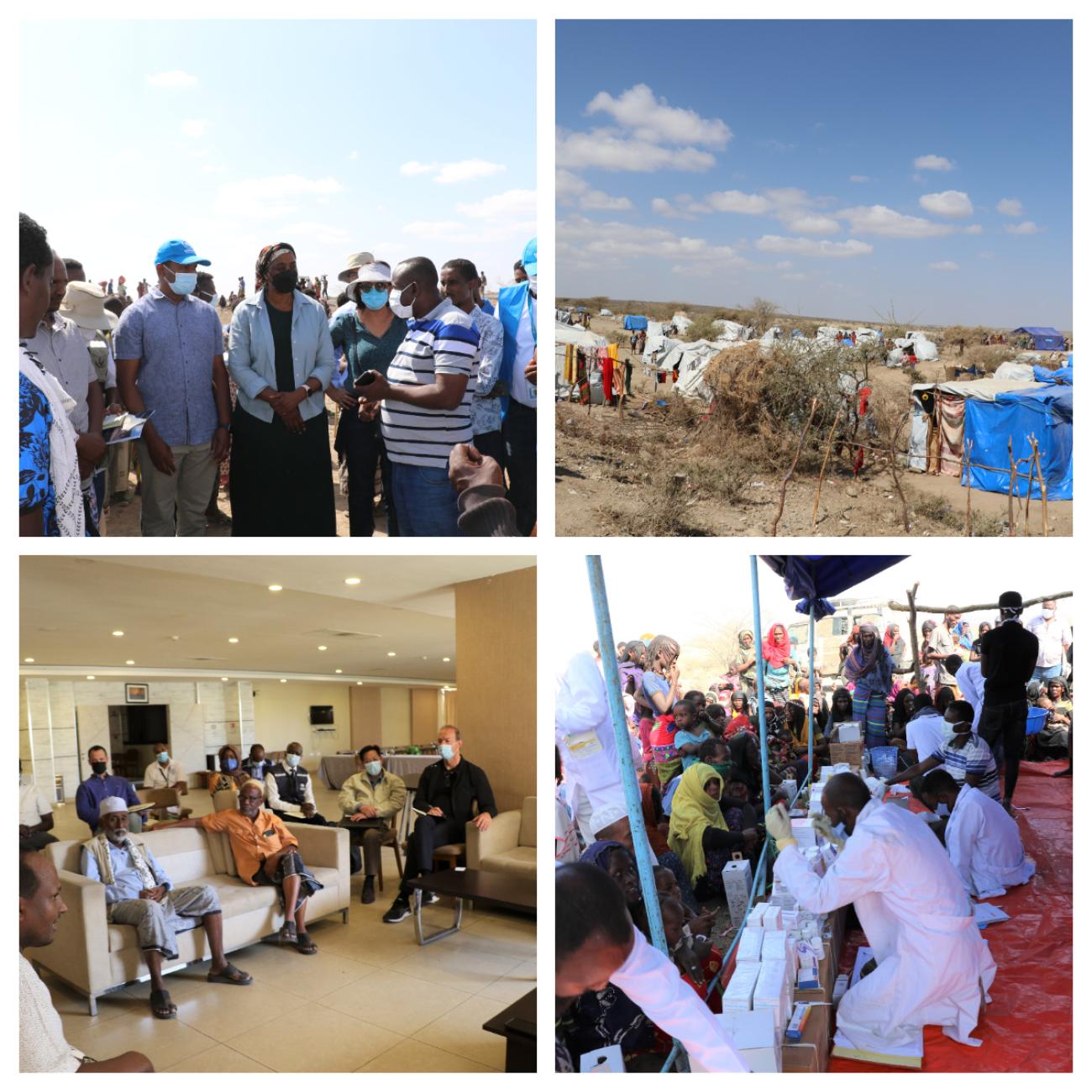Ethiopia Humanitarian Country Team visits IDPs, humanitarian response in Afar

The Ethiopia Humanitarian Country Team (EHCT) led by UN Resident and Humanitarian Coordinator conducted a field visit to Afar region from 12-14 December.
The visit aims to reach out and engage with Afar regional leadership and community leaders on the humanitarian situation, get first-hand update on the humanitarian situation in Afar- including needs on ground and on-going response and explore ways of scaling up the response to support the regional Government in addressing humanitarian needs in the region.
According to the Disaster Prevention and Food Security Programme Coordination Office (DPFSPCO), more than 1.3 million people are directly or indirectly affected by the conflict and over 376,000 persons are displaced in the region.
During the visit, UN Resident and Humanitarian Coordinator Dr. Catherine Sozi, discussed with Afar Region President Awol Arba on the humanitarian situation in the region and the UN and partners' response to address the substantial unmet needs.
Dr. Sozi together with the Ethiopia Humanitarian Country Team also discussed with community leaders on scaling up the humanitarian assistance in Afar to reach people in need and ensuring continued access to deliver humanitarian commodities to Tigray. The community leaders expressed their commitment to continue to facilitate humanitarian operations to affected civilians in Tigray via Semera corridor. However, they expressed their concern that the people affected by the conflict in Afar region, which serves as a transit for humanitarian cargo to Tigray, have not received adequate humanitarian support.
Similarly, officials of Afar region noted that the region has already been vulnerable to a number of natural disasters and the conflict has exacerbated the suffering of the people in the region.
In Afar, the EHCT visited the internally displaced people (IDPs) and activities of the UN and partners to meet the humanitarian needs of conflict affected people in two IDPs sites – Wake50 and Waranso. Over 54,000 IDPs are sheltered in Wake50 and Waranso IDP sites while the majority of the IDPs in the host community are living in Mille town.
Initial priority needs of the displaced population include emergency food, water, hygiene and sanitation (WASH), emergency shelter, non-food items, primary health care services, nutrition, protection and livelihood opportunities.
UN and partners’ response
The UN and partners have provided humanitarian assistance to the conflict affected areas in the region. WFP is targeting 534,000 food insecure people in 14 woredas. So far 129,370 beneficiaries (24%) have received food in four woredas. Islamic Relief distributed 1,800 quintals of wheat flour; 18,000 liters of cooking oil and standard non-food items (NFIs) to 2400 households in Wake 50IDPs site in Chifra. AMREF distributed 200 quintals of wheat flour, 400 litres of cooking oil to 400 households in Asbolo-Waranso Hurmati IDP site in Mille.
As to health and nutrition support, UNICEF provided funding for capacity building of health professionals on Severe Acute Malnutrition (SAM) management, mass mid-upper arm circumference (MUAC) screening for children and pregnant and lactating women (PLW), last-mile transport support to the woredas, food for caretakers, and coordination.
WFP has provided blanket supplementary feeding to nearly 78,000 (nearly 60,000 children under 5 and 18,000 pregnant and lactating women) in seven conflict-affected woredas and targeted supplementary feeding to nearly 100,000 people.
There is an urgent need for water trucking and overhaul of the water system in all the IDP sites and host communities in two most affected zones of the region. In November, UNICEF and its partners reached 104,901 people through emergency water supply including water trucking and repairs/maintenance of durable water supply schemes. Also, UNICEF, through the Regional Water Bureau (RWB) and Afar Pastoralist Development Association (APDA) distributed critical lifesaving WASH supplies to over 95,000 IDPs and conflict affected people. Similarly, hygiene promotion activities are ongoing in IDP sites and rural kebeles of Teru, Awura, Ewa, Chifra and Dubti for over 73,000 people through APDA.
UNICEF also deployed 30 Mobile Health and Nutrition Teams currently providing lifesaving services and medical consultations including severe acute malnutrition (SAM) treatment integrated with infant and young children feeding (IYCF) and micronutrient supplementation in the affected locations.
The two main coordination platforms in the Afar region include the Government-led Emergency Coordination Center (ECC) and OCHA-led Inter-Cluster Coordination Group (ICCG). An access working group has also been activated in Semera for partners to discuss access related issues.
The Ethiopia Humanitarian Country Team also discussed with representatives of local and international NGOs operating in Afar in order to strengthen coordination and partnership in providing humanitarian assistance to the conflict affected people. EHCT also pointed out the need to strengthen partnership with local NGOs and their access to humanitarian funds.
After visiting the projects and meeting with representatives of partners and governments, EHCT underscored the need to mobilize more resources to scale up response in the region to address the needs - especially needs of IDPs and host community, including recovery, rehabilitation, and livelihoods.
EHCT also underlined the need to enhance coordination among all actors, on emergency relief, emergency rehabilitation, resilience/recovery for life saving and durable solutions.

















